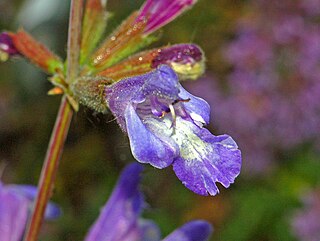
Pyraustinae is a large subfamily of the lepidopteran family Crambidae, the crambid snout moths. It currently includes about 1,280 species Most of them tropical but some found in temperate regions including both North America and Europe.

The Pyralinae are the typical subfamily of snout moths and occur essentially worldwide, in some cases aided by involuntary introduction by humans. They are rather rare in the Americas however, and their diversity in the Australian region is also limited. Altogether, this subfamily includes about 900 described species, but new ones continue to be discovered. Like many of their relatives in the superfamily Pyraloidea, the caterpillar larvae of many Pyralinae – and in some cases even the adults – have evolved the ability to use unusual foods for nutrition; a few of these can become harmful to humans as pests of stored goods.

Salvia interrupta is a perennial plant belonging to the family Lamiaceae. It is native throughout the range of the Atlas Mountains in Morocco, growing between 1,300 to 1,500 ft elevation in shaded arboreal forests and on limestone slopes.

Tetridia is a monotypic moth genus of the family Crambidae described by William Warren in 1890. Its single species, Tetridia caletoralis, was described by Francis Walker in 1859. It is found in China, northern India, Sri Lanka, Myanmar, Malaysia, Papua New Guinea, Japan, Taiwan and Australia, where it has been recorded from Queensland.
Sasunaga is a genus of moths of the family Noctuidae.

Mycena interrupta is a species of mushroom. It has a Gondwanan distribution pattern, being found in Australia, New Zealand, New Caledonia and Chile. In Australia, it is found in Victoria, Tasmania, New South Wales, South Australia, and Queensland, where its distribution is limited to Lamington National Park.

Hypodoxa is a genus of moths in the family Geometridae described by Prout in 1912.

Opisthoxia is a genus of moths in the family Geometridae.

Perizoma is a genus in the geometer moth family (Geometridae). It is the type genus of tribe Perizomini in subfamily Larentiinae. The tribe is considered monotypic by those who include the genera Gagitodes, Martania and Mesotype in Perizoma. Some other less closely related species formerly placed here are now elsewhere in the Larentiinae, e.g. in Entephria of the tribe Larentiini.

Pingasa is a genus of moths in the family Geometridae first described by Frederic Moore in 1887.

Josia is a genus of moths of the family Notodontidae erected by Jacob Hübner in 1819.

Eupitheciini is a tribe of geometer moths under subfamily Larentiinae, often referred to as pugs. The tribe was described by Tutt in 1896.

Phazaca is a genus of moths in the family Uraniidae first described by Walker in 1863.

Phazaca theclata is a moth of the family Uraniidae. It was first described by Achille Guenée in 1858. It is known from Africa south of the Sahara, from Saudi Arabia, as well as from India, Japan, Myanmar, Nepal and Sri Lanka.
Diadelia interrupta is a species of beetle in the family Cerambycidae. It was described by Fairmaire in 1896.
Gyrosmilia is a monotypic genus of large polyp stony coral. It is represented by a single species, Gyrosmilia interrupta. It was first described by Christian Gottfried Ehrenberg in 1834 as Manicina interrupta.

Phazaca erosioides is a moth of the family Uraniidae first described by Francis Walker in 1863. It is found in the Indo-Australian tropics from Sri Lanka to New Guinea.













